SOUTH AND SOUTHEAST ASIA, 1636
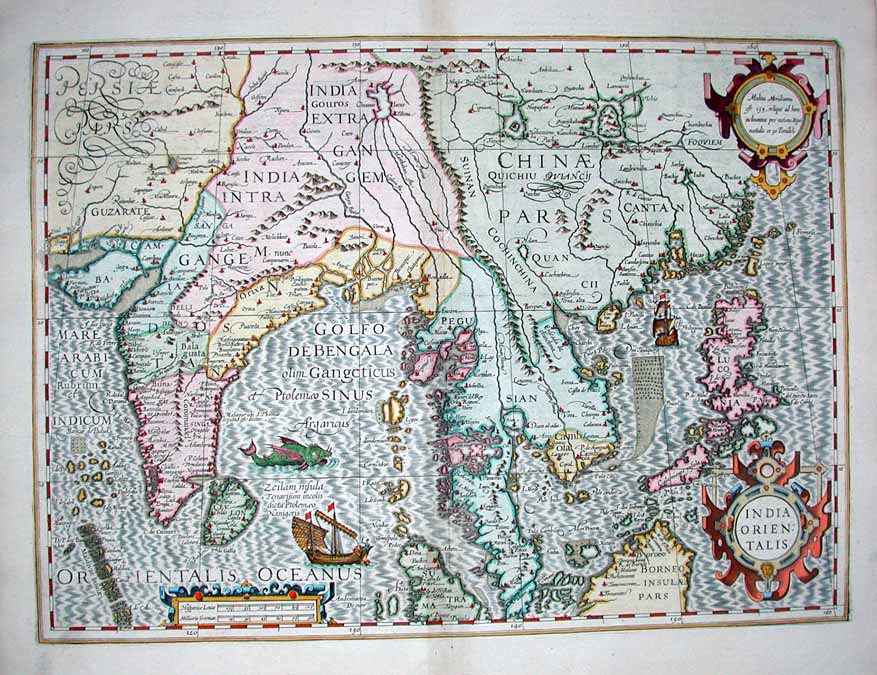
SOUTH AND SOUTHEAST ASIA, 1636

A Mercator/Hondius map of South and Southeast Asia, published in 1636, with modern, very elaborate hand coloring
"India Orientalis. 49 x 35.5 cm copperplate engraving, 56 x 44 cm sheet size, modern hand colour, Amsterdam, engraved 1606, printed 1636."
The seller, *regiomontanus*, has provided interesting commentary that's given here almost in full:
"We are pleased to offer this scarce and important original map of India and southeast Asia by the master engraver and cartographer Jodocus Hondius (1563-1612) from the 1636 English language edition of the Mercator/Hondius Atlas, Or A Geographicke Description of the World. The map incorporates some elements of the Ortelius Indiae map of 1570, but the map is entirely an original composition that despite obvious inaccuracies significantly advanced the depiction of the region beyond Ortelius' efforts. Unquestionably the most famous cartographer of all time, Gerard Mercator (1512-1594) envisioned his Atlas even before his friend Abraham Ortelius began work on his Theatrum, but it was late to publish, limited in geographic coverage, and never acheived commercial success in his lifetime or under the administration of his sons. However, with the addition of some 40 maps by Hondius (including this map) and Hondius' purchase of Mercator's plates from his heirs in 1604, an expanded and reissued "Mercator/Hondius" Atlas was published to great acclaim, eventually issued in nearly 50 editions in several languages. This beautifully engraved map is rich with fascinating decorative elements and is one of the most prized of all the Mercator/Hondius maps.
We begin our survey of the map with the south China coast where a handsome galleon sails - note Macao already a prominent city as Portugese influence in the region was predominant at the time:
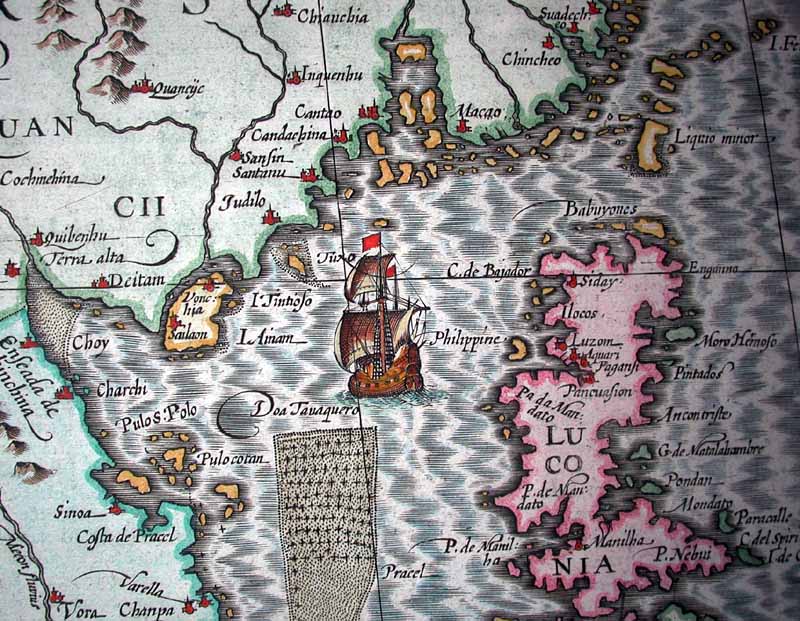
Decorative title cartouche:
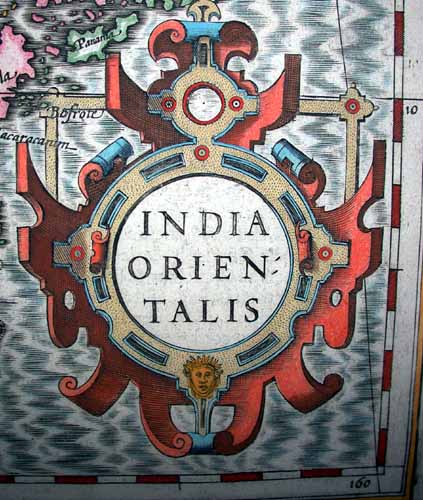
Mercator, being of a scientific bent, did not particularly care for decorative elements such as this charming sea monster, and his maps suffered in comparison to Ortelius as a result. Hondius was quick to correct this marketing error wherever necessary:
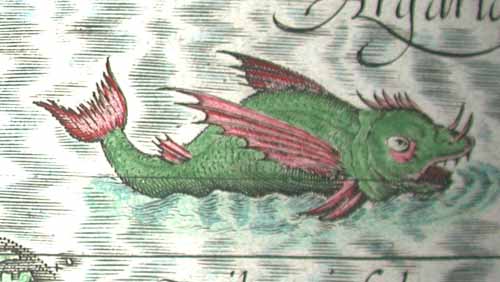
The engraving work and calligraphy is of the highest order - to get a sense of detail consider that the distance from Goa to Calicut along the Malabar coast as seen in this enlarged photo south to "Ambihau" measures just 4 cm actual size:
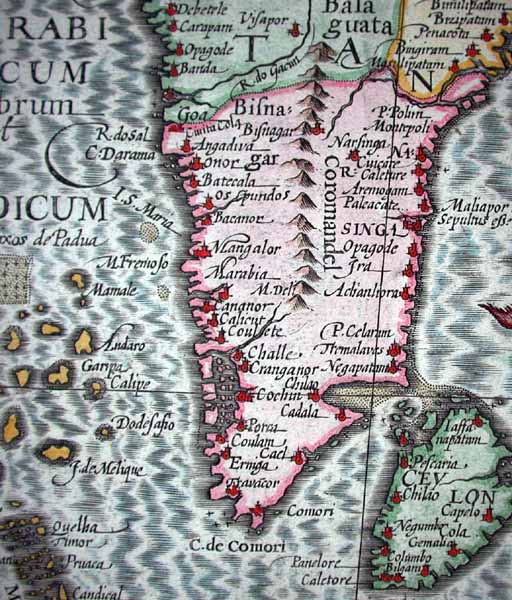
It is interesting to note that the Hondius family, and Jan Jansson, who took control of the plates after the death of Henricus Hondius in 1638, marketed even atlas volumes that mainly contained maps such as this, engraved years after Mercator's death, as "Mercator/Hondius". Mercator's eponymous projection, which in the felicitous phrase of his recent biographer Nicholas Crane "reconciled the sphere and the plane", and his unsurpassed dedication and skill as a cartographer and engraver infused the name "Mercator" with a cachet second to none. The famous frontispiece for the Mercator/Hondius atlases shows Hondius senior in fruitful collaboration with the great man himself, a wholly fictitious scenario. Still, the Hondius clan deserves great credit for rejuvenating Mercator's Atlas and bringing to fruition the kind of cartographic collection Mercator originally envisioned. Note the small dog by the armillary sphere - symbol of the Hondius family and their printer's mark De wackere Hondt (the watchful dog):
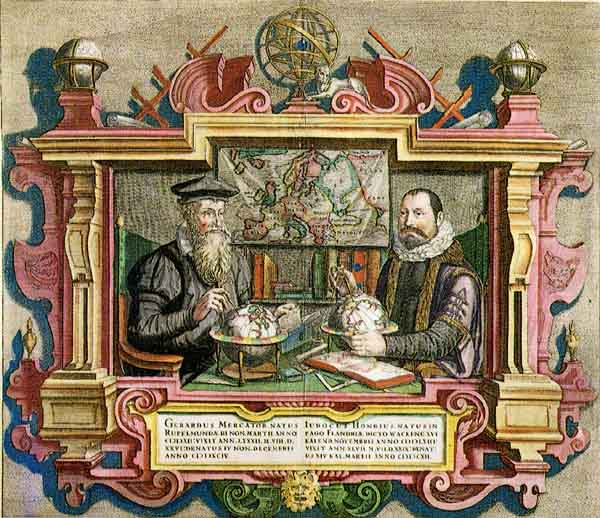
Note the significant distortions of the Gulfs of Khambhat and Kachchh, leading to a dramatically "thinned" subcontinent:
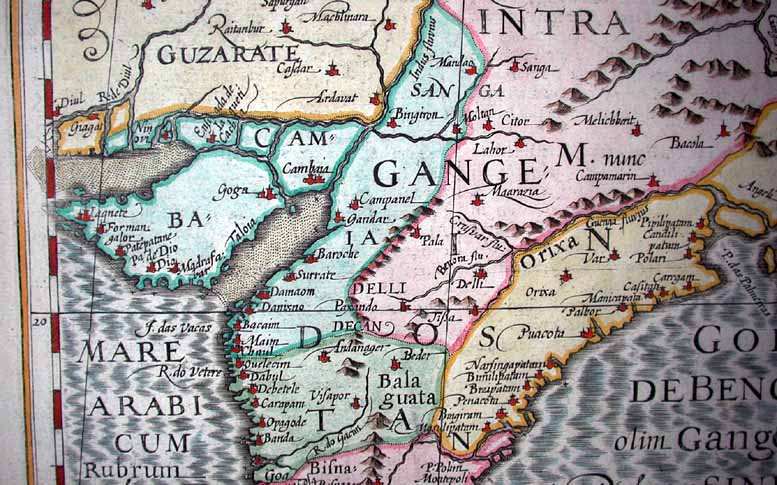
The text on verso, assembled by Hondius and his sons from a number of sources including Ortelius and embellished by the English translator Henry Hexham, is a fascinating document in itself. We are pleased to present some representative passages below:
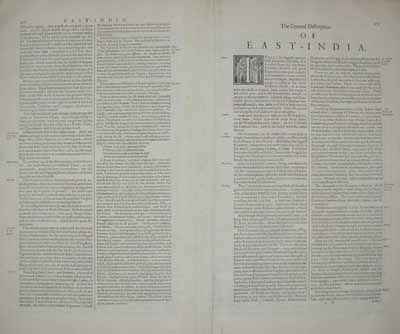
"The General Description of East- IndiaThere are also an infinte number of Serpents, which the Indians eate, after they have roasted them, as they doe a kind of Ants which they eate with pepper as wee doe Crabbs. There are also found white Apes and Chamaeleons, which live only by the aire & can transforme themselves into any colour...
The people are indifferently civill and ingenious. Both men and women imitate a majesty in their going and apparrell which they sweeten with oyles and perfumes, adorning themselves with Jewels, Pearles and other ornaments befitting...
The Brachmanni are had in great reverence, and live for the most part a very austere and a solitary life in Caves and Deserts, feeding on herbes, wearing poore and thinne weedes and for a certaine time doe abstaine from all kind of wickednesse. But that time once past, may (as it were) by priviledge defloure Virgins and committ what riots they list. They are skillful in Astrologie, Philosophie and Physicke...
Moreover the people of Narsinga use to burne their wives with their husbands and shee is thought to have bene most loving, during his life, which now most willing to accompany him in his death & offer herselfe to his Manes at the Funerall pile...
Touching their Lawes and Statutes, the most them lived without any written Lawes, others governed themselves according to their written Lawes in which they use simplicity without guile, as they doe likewise in all their contracts & dealings, & are never given to dispites or controversies; for they trust out any wares or commodites, neither use any obligations or morgages, but credit one another simply upon their bare word..."
== Mughal index == Main map index == Glossary == FWP's main page